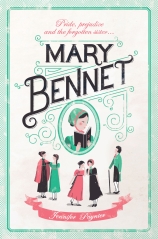The essayist Sydney Smith, a contemporary of Jane Austen, famously defined pedantry as ‘the ostentatious obtrusion of knowledge’. Quite apart from the serendipitous pun—ostentatious—it’s a definition which fits the third sister in Austen’s Pride and Prejudice perfectly. Mary Bennet obtrudes her knowledge at every opportunity. She really is a bit of a pain.
Mary makes her first appearance in the second chapter of Pride and Prejudice, sarcastically framed by her father as a ’young lady of deep reflection’ who reads ‘great books and makes extracts’. A little later, Jane Austen tells us that Mary’s singing shows ‘neither genius nor taste’, that she is ‘always impatient for display’ and has ‘a conceited manner’ and ‘a pedantic air’.
Fashioning a heroine out of such unpromising material might seem daunting—if not downright perverse. As one editor of my novel, Mary Bennet, commented: ‘I feel that Mary needs to be a little more engaging/likeable. Obviously you’ve based her on the character in Pride and Prejudice, but if she is to be the protagonist, we need to empathise with her to some degree.’ (For a wonderful article on ‘likeability’ in fictional characters, see Charlotte Wood’s blog. But the editor’s comment did point to my difficulty in reimagining Mary. On the one hand, I wanted to stick to Austen’s script and not ignore unattractive aspects of the character, but I also wanted the reader to empathise with Mary, to appreciate what a difficult hand she’d been dealt. She’s ‘the only plain one’ of the five Bennet sisters after all, and as a middle child she’s isolated within her own family, having no confidante among her sisters. And neither of her parents favours her— Mrs Bennet spoils her youngest daughter, Lydia, while Mr Bennet always gives his second daughter, Elizabeth, the preference.
For me, the key to understanding Mary lies in her childhood—her birth-order as the third successive daughter of parents desperate for a male heir, her loneliness growing up between two pairs of closely bonded sisters, and—hardest of all perhaps—having to endure the brilliant unkindness of her capricious quick-witted father. (I originally conceived Mary Bennet as a novella about Mary’s childhood and adolescence, a prequel to Pride and Prejudice, and I write about this in more detail on my website. But inevitably, in trying to better understand Mary, the sister closest to her in age—Elizabeth Bennet—is seen in a less favourable light. And Elizabeth is not only one of literature’s best-loved heroines, she’s also beloved by her creator: Jane Austen in a letter to her sister, Cassandra, writes: ‘I must confess that I think her as delightful a creature as ever appeared in print, & how I shall be able to tolerate those who do not like her at least, I do not know.’ (Letter [79] 29/1/1813)
My Mary doesn’t much like Elizabeth– she’s more than a little jealous of her of course—but I can’t help feeling that Jane Austen didn’t much like Mary! Austen had no time for people who ‘ostentatiously’ obtruded their knowledge. In a letter to the Prince Regent’s librarian, she writes of herself: ‘I think I may boast myself to be, with all possible vanity, the most unlearned and uninformed female who ever dared to be an authoress.’ (Letter [132(D)] 11/12/1815)
With thanks to Heidi McCourt, Publicist, Penguin Group (Australia), for organising this post.




 Posted by whisperinggums
Posted by whisperinggums 